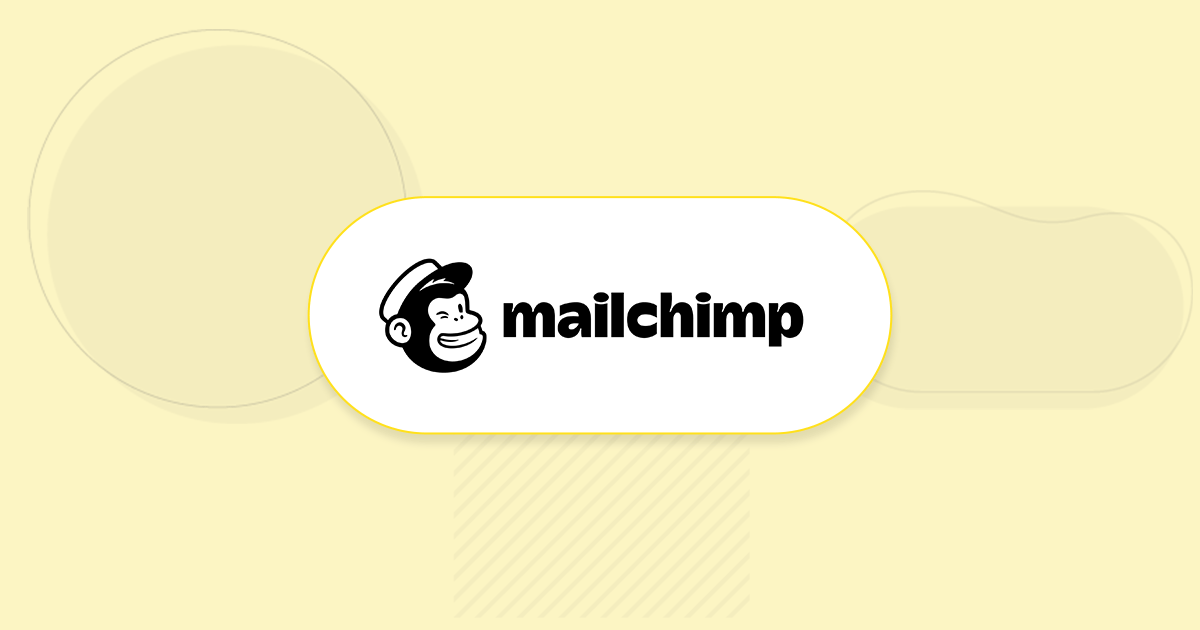
Mailchimp vs GetResponse: Which Email Platform Is Better? [2025]
If you’re looking for new email marketing software, you might have come across the dilemma: Mailchimp vs GetResponse. Which one is the best for your business?
The bad news is there’s no quick answer.
The good news is that our Mailchimp vs GetResponse review will help you decide. We test their features, overall ease of use, marketing automation capabilities, customer support, pricing model, and more to see which service comes out on top.
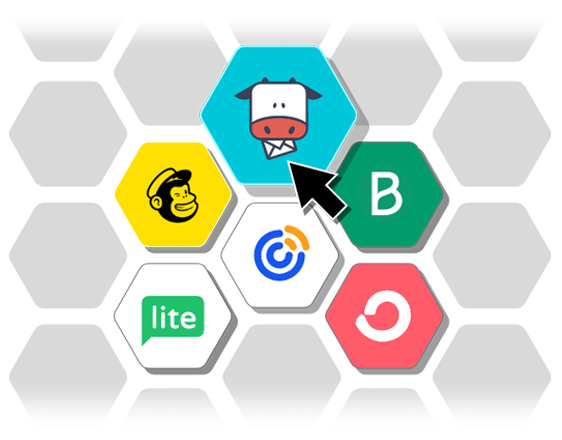
Save $$$ of your marketing budget by switching to Moosend today!
Mailchimp vs GetResponse: Feature Comparison
Here we have a quick comparison table to get you started.
| Mailchimp | GetResponse | |
| Free plan | Yes (limited) | Yes |
| Pricing | $13/month (500 contacts – 5,000 emails) | $19/month (1,000 contacts – unlimited emails) |
| Best for | eCommerce, Publishers, SMBs | Ecommerce, Marketers, Agencies, B2B businesses |
| Email tools | Email builder, 137 pre-made templates, Content studio | Email builder, 237 newsletter templates, A/B testing |
| Marketing automation | Advanced | Advanced |
| Reporting & Analytics | Extensive | Extensive |
| Landing pages & Signup forms | Yes | Yes |
| SMS marketing | Yes (add-on) | Yes (MAX plan) |
| Deliverability | 93% | 90% |
| Integrations | 335 | 185 |
| Customer support | Knowledge base, email support, chat and phone support | Email & live chat, phone support, webinars, help center |
| AI features | AI content generation for email only (beta), Subject line helper, AI-generated automations (beta) | AI subject line helper, AI-powered website builder, AI autoresponder generator, AI course creator, AI landing page builder |
Now let’s see more details about each category.
Setup & Ease of Use
Mailchimp:
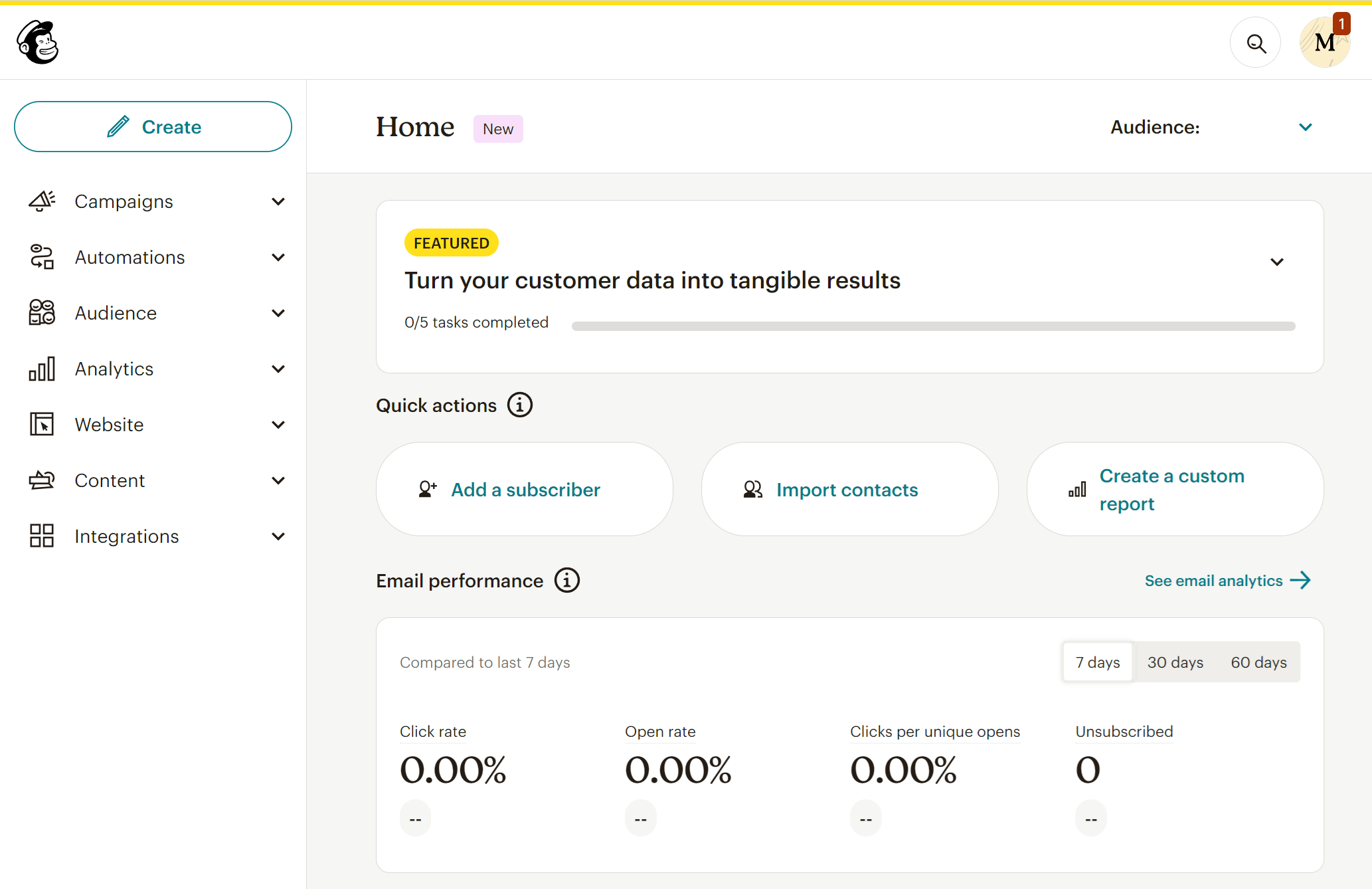
Mailchimp is designed to be user-friendly, allowing users to quickly learn its features and functionalities. Setting up an account is straightforward, taking just a few minutes and a few clicks.
The platform’s navigation is intuitive, with a left sidebar for easy access and a convenient “Create” button that streamlines the process of crafting campaigns, automations, forms, and more without the need to search extensively.
However, we found out that locating created forms and landing pages can be challenging. Their placement isn’t immediately apparent, which may lead to unnecessary frustration for users unfamiliar with the interface. Despite this minor inconvenience, Mailchimp offers a smooth overall experience, though there is room for improvement in certain areas.
GetResponse:
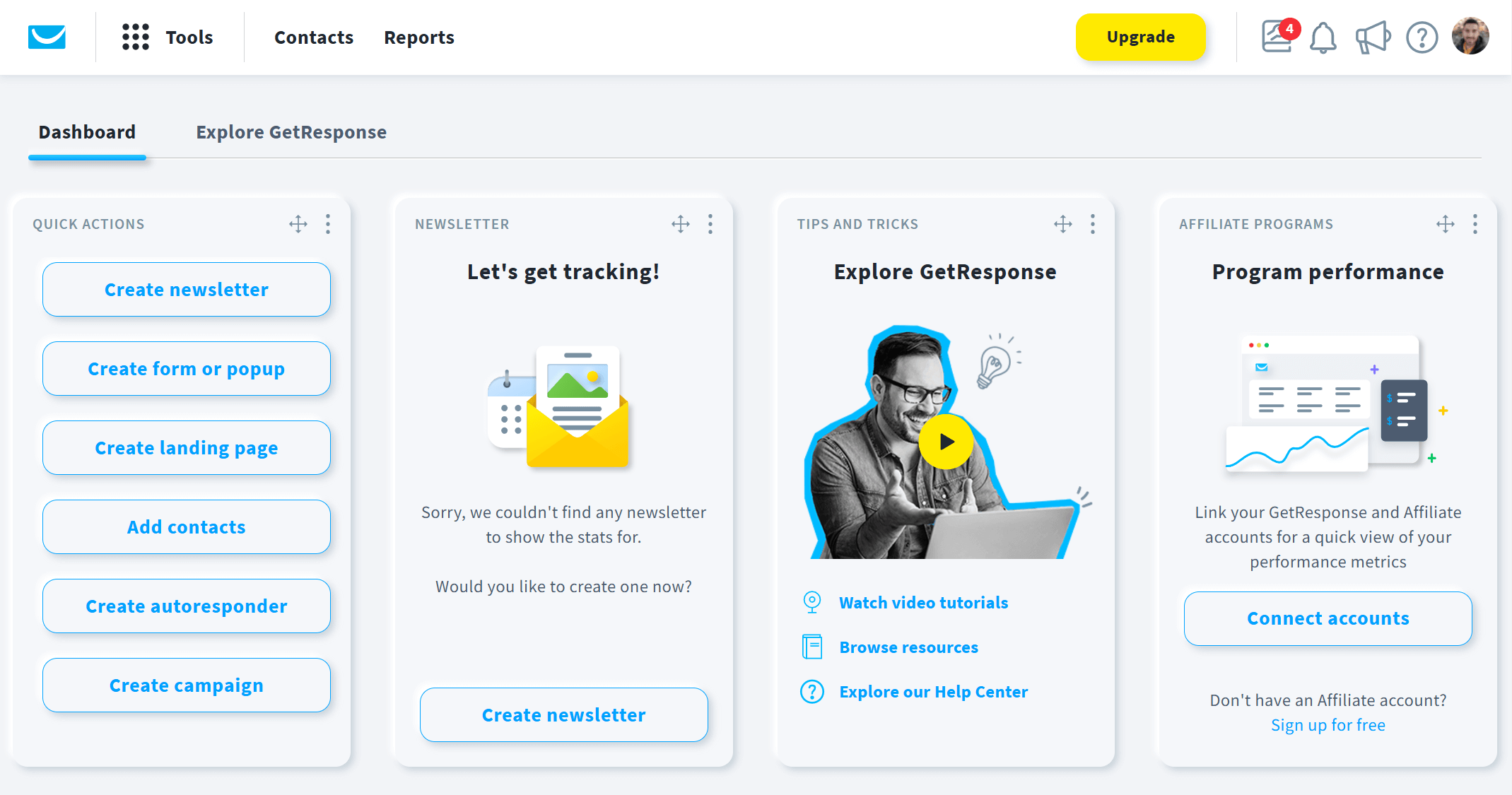
During our GetResponse review, we found a modern, fast, and user-friendly interface that is easy to navigate, even for users with no prior experience in marketing tools. Its intuitive design ensures you can quickly familiarize yourself with the platform and start launching marketing campaigns efficiently.
The “Quick Actions” widget is particularly useful, offering easy access to key tasks such as creating emails, popups, adding contacts, or initiating marketing automation workflows. For a more traditional navigation approach, the Tools menu at the top provides access to all available features.
New users have the option to explore the platform independently or follow an interactive tutorial upon their first login. For those unfamiliar with email marketing or the tool, the tutorial is highly recommended to make the onboarding process seamless and effective.
Winner: Both email marketing services have a clean design and straightforward navigation. Despite the differences in aesthetics, users will have a similar experience with both platforms. It’s a tie.
Email Builder
Mailchimp:
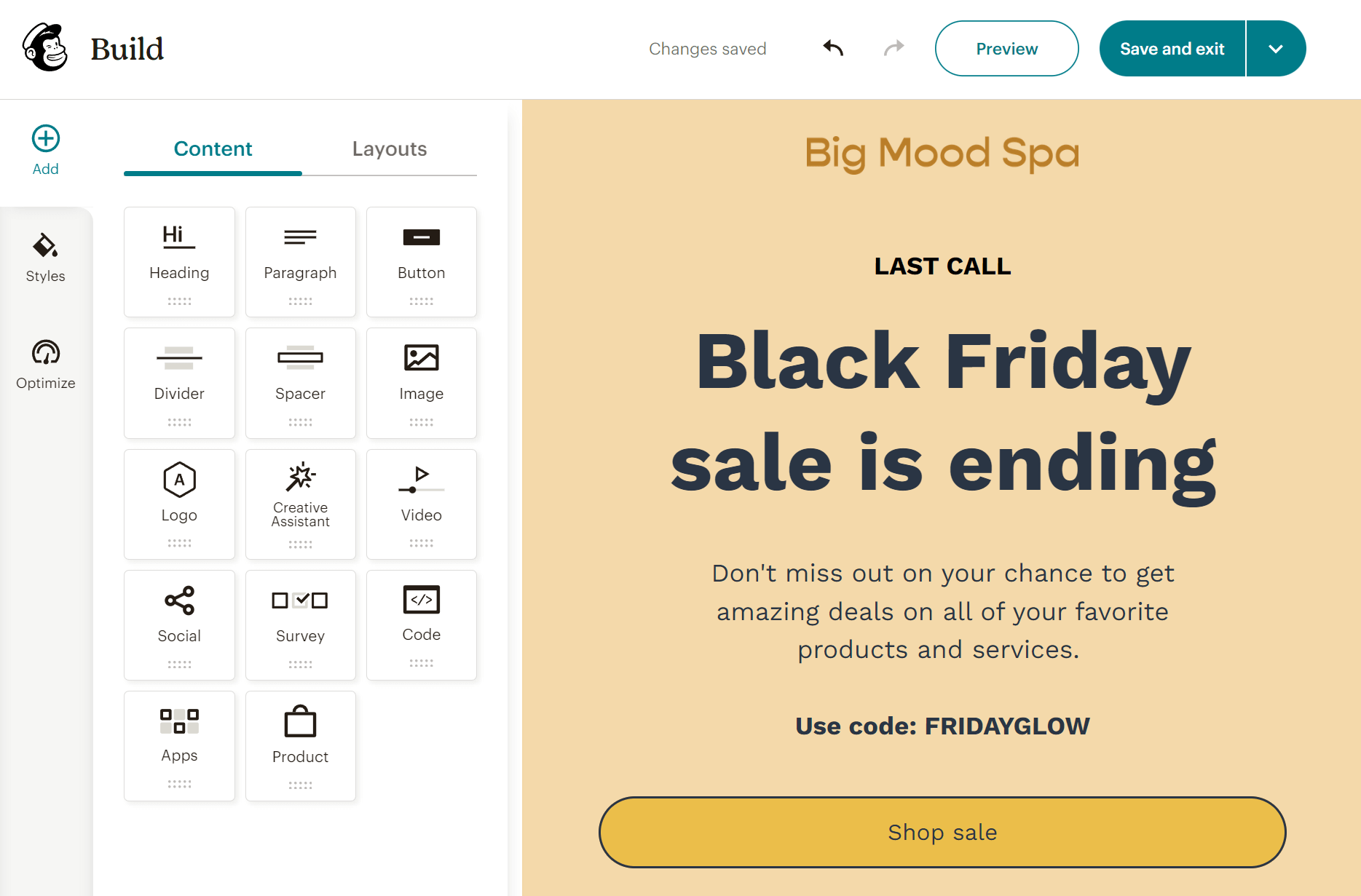
Mailchimp’s email builder stands out for its speed, intuitive design, and a robust selection of features that cater to both beginners and experienced marketers. We found a wide range of tools to create engaging emails, allowing users to seamlessly add images, videos, buttons, surveys, and even custom HTML code for more tailored designs.
For eCommerce users, the ability to connect your store with Mailchimp is a significant advantage, as you can add products directly to emails and include personalized product recommendations to drive sales.
Customization of email campaigns is straightforward—users can simply click on any email element to edit it, making it easy to refine content without navigating complex menus. One particularly noteworthy feature is the “Optimize” button, which provides actionable suggestions to improve your campaign, ensuring emails are error-free and more effective.
For those on the Standard or Premium plans, Mailchimp offers an AI-powered content generator, which streamlines the process of creating compelling copy, saving time while maintaining quality.
Overall, Mailchimp’s email builder delivers a user-friendly experience with powerful tools to create polished, professional campaigns.
GetResponse:
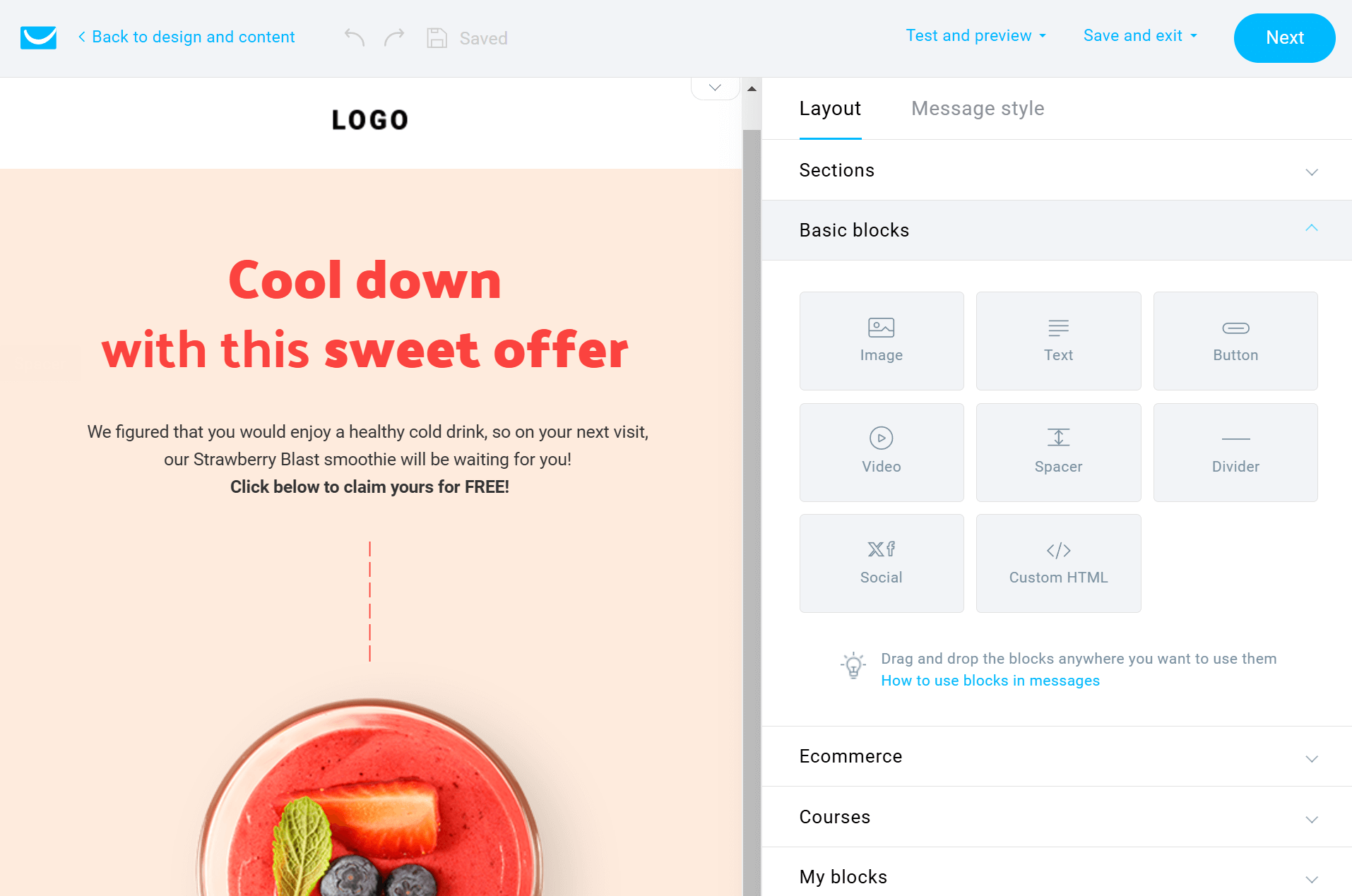
GetResponse has a great drag-and-drop editor that’s clean and responsive. To customize your email campaign, you click on the element you want and make the necessary changes. You can add images, text, buttons, and videos as well as more advanced eCommerce items like promo codes, products, and product recommendations. You can also promote your online courses by adding a course block. As such, GetResponse can cover the needs of marketers, creators, and eCommerce brands.
Another handy feature of GetResponse’s email editor is the ability to add, save, and reuse different sections and blocks. This can save crucial time if you work on email campaigns regularly.
You can also optimize your emails for mobile devices. The platform lets you hide certain elements on mobile devices and reverse the order of columns for a seamless experience on smaller screens.
If you run out of ideas or need help fine-tuning your copy, GetResponse has an AI assistant that eliminates writer’s block and generates email copy for you. Finally, the email builder includes tools for spam check, inbox preview, and dark mode preview.
Winner: Both marketing software offer advanced features so that you can create beautiful email newsletters. We wouldn’t say that one is better than the other, so it’s a tie.
Templates
Mailchimp:
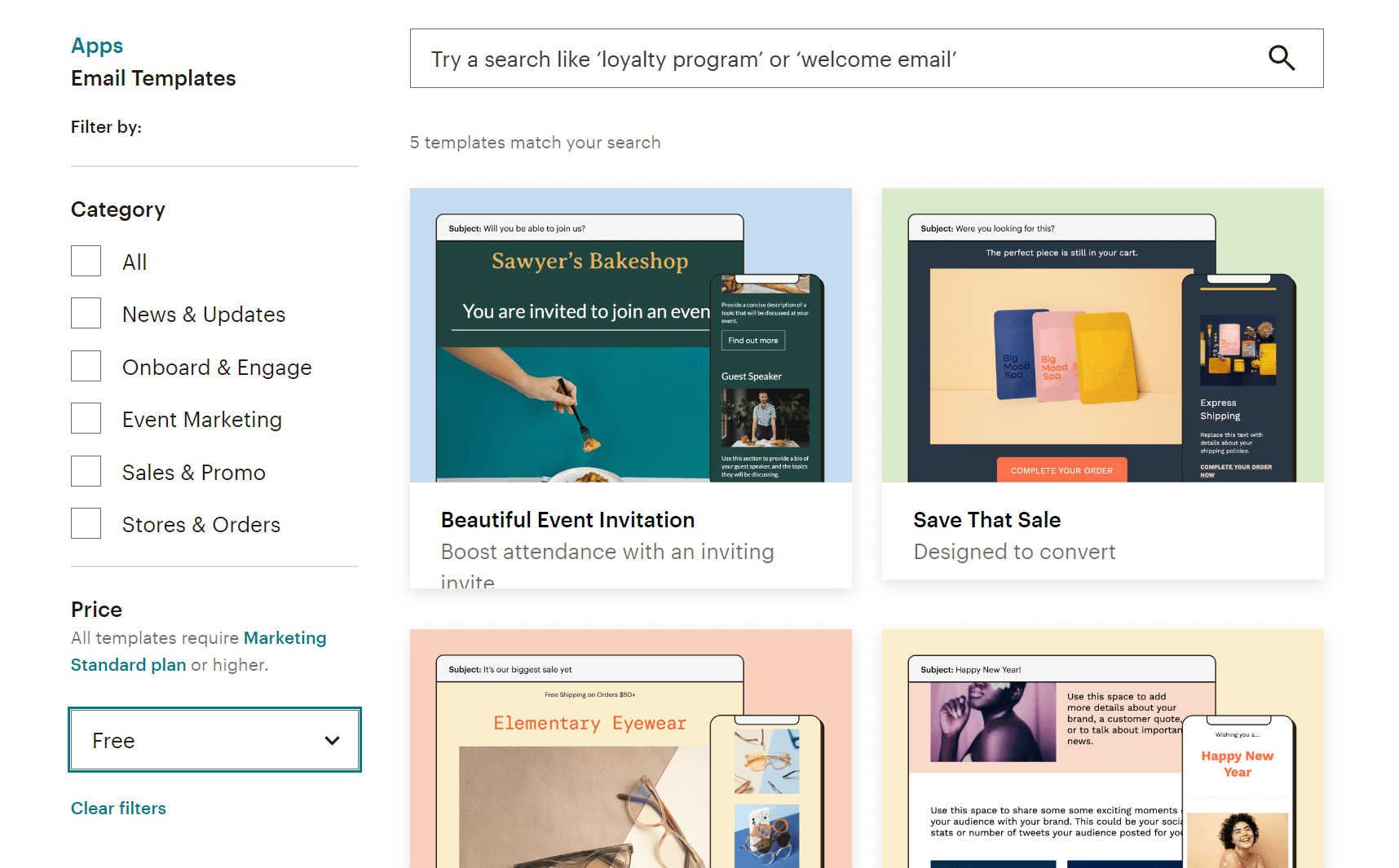
Mailchimp’s template library offers a broad selection of 137 pre-designed templates tailored to various industries and campaigns. They are aesthetically pleasing and can be easily customized, while their responsive layouts ensure emails look great on any device.
Compared to GetResponse and other alternatives, customization options may feel limited, especially for more advanced users. Nevertheless, they are ideal for quick email creation, when campaigns don’t require advanced customization.
The main pain point here is that Mailchimp users on the free plan can only access 7 basic designs. This is not the case with GetResponse, which makes templates available for all users.
GetResponse:
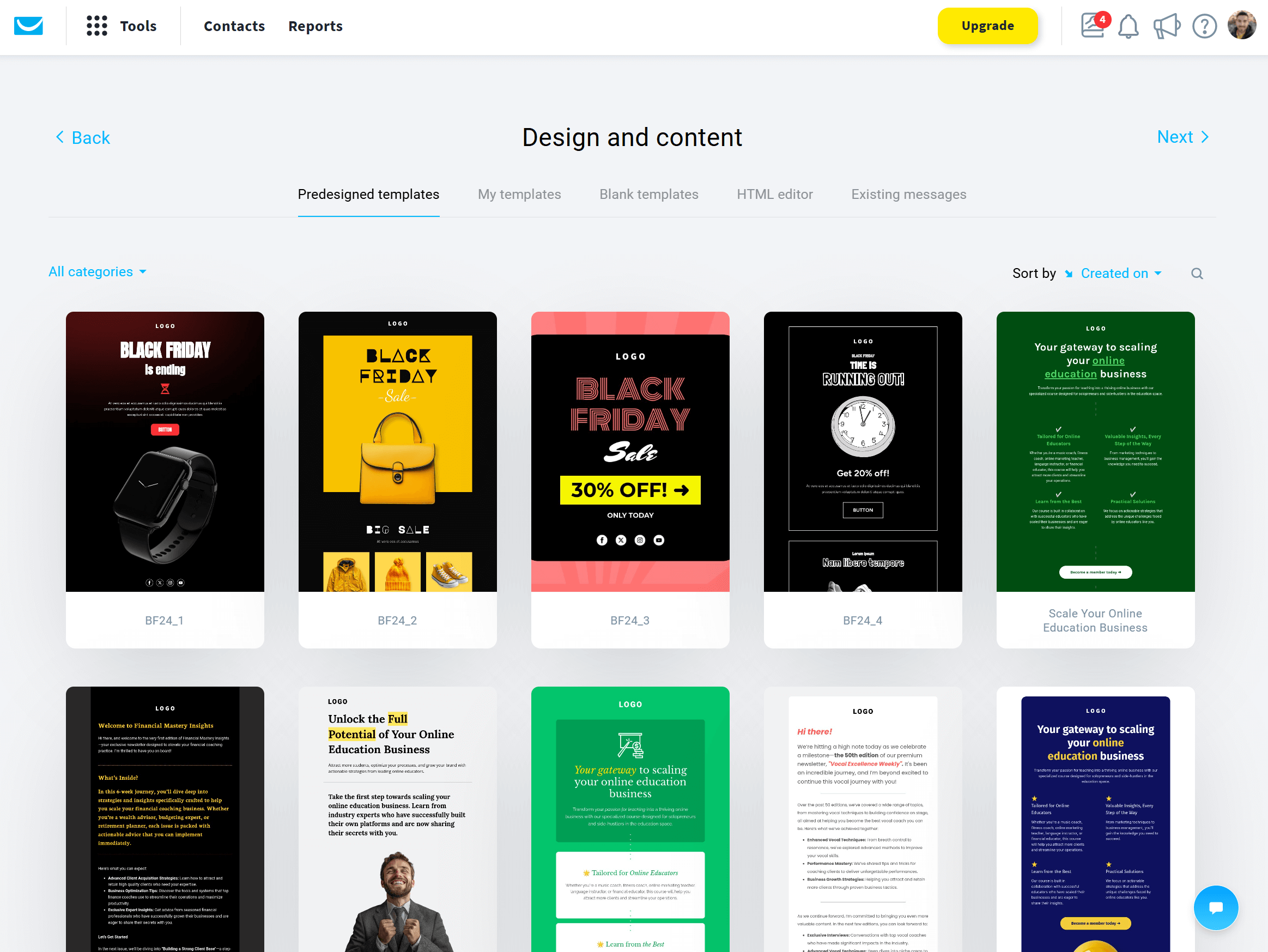
GetResponse comes with 237 high-quality email newsletter templates that are also mobile responsive. They can cover various needs like welcoming subscribers, re-engagement, product promotion, and webinar invitation.
These templates are fully customizable, so they are an excellent starting point when you need to craft a quick email campaign.
Winner: GetResponse offers a bigger variety of email templates, plus they are of higher quality compared to Mailchimp’s. Getresponse takes the win!
Marketing Automation
Mailchimp:
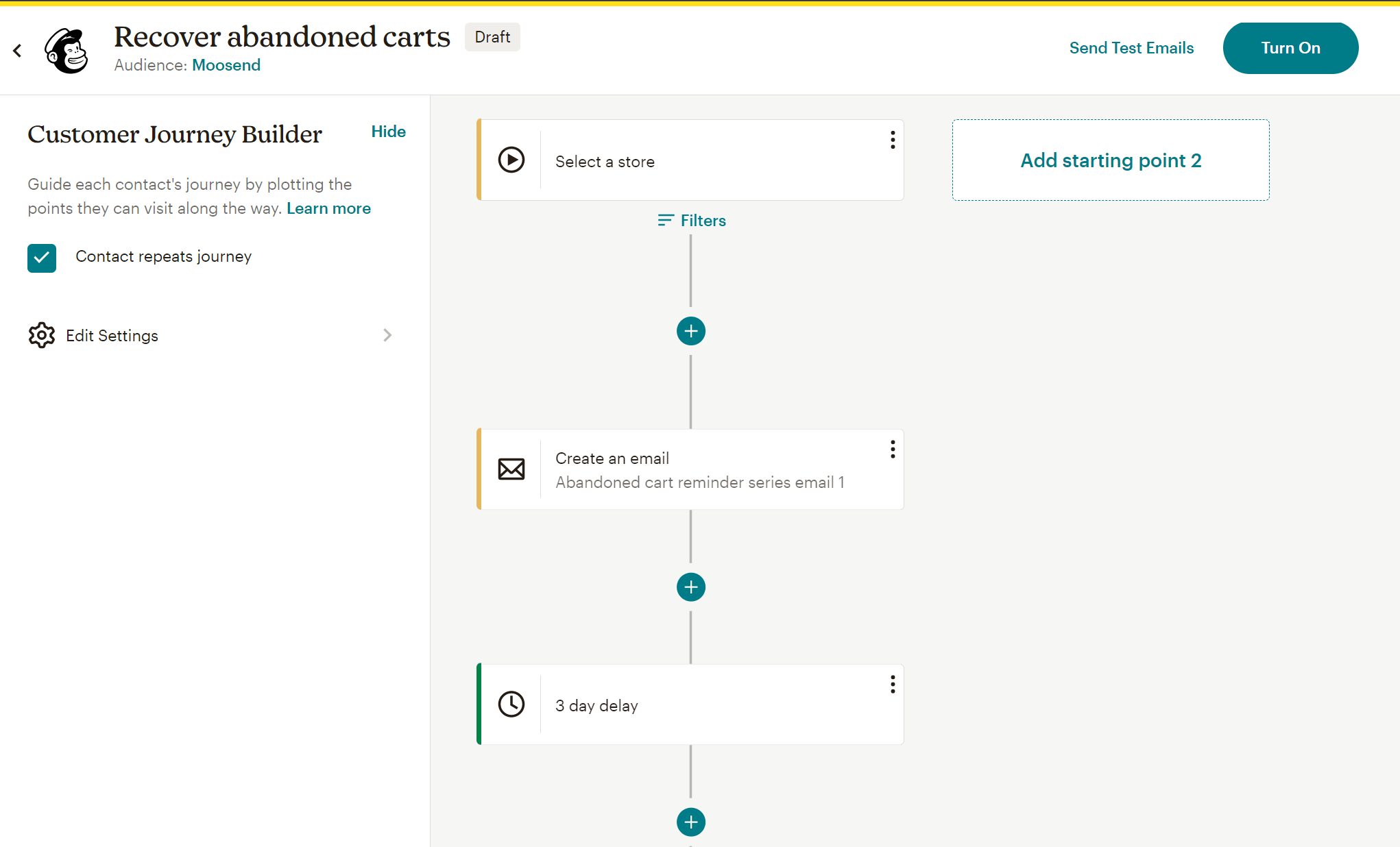
Mailchimp’s Customer Journey Builder has an intuitive interface that makes it easy to use for both beginners and advanced users. You’ll be able to set up automated welcome emails, abandoned cart reminders, thank you messages, and more.
We also found 100+ pre-built journeys that can help you set up a complete marketing strategy to reach, engage and convert your audience. And if you want to craft a custom workflow, there is a wide range of triggers and actions for your sequences.
It’s important to mention that Mailchimp’s automation templates are categorized based on their goal, such as nurturing leads, re-engaging contacts, etc. This is immensely helpful for new users since they understand immediately what each template is used for.
GetResponse:
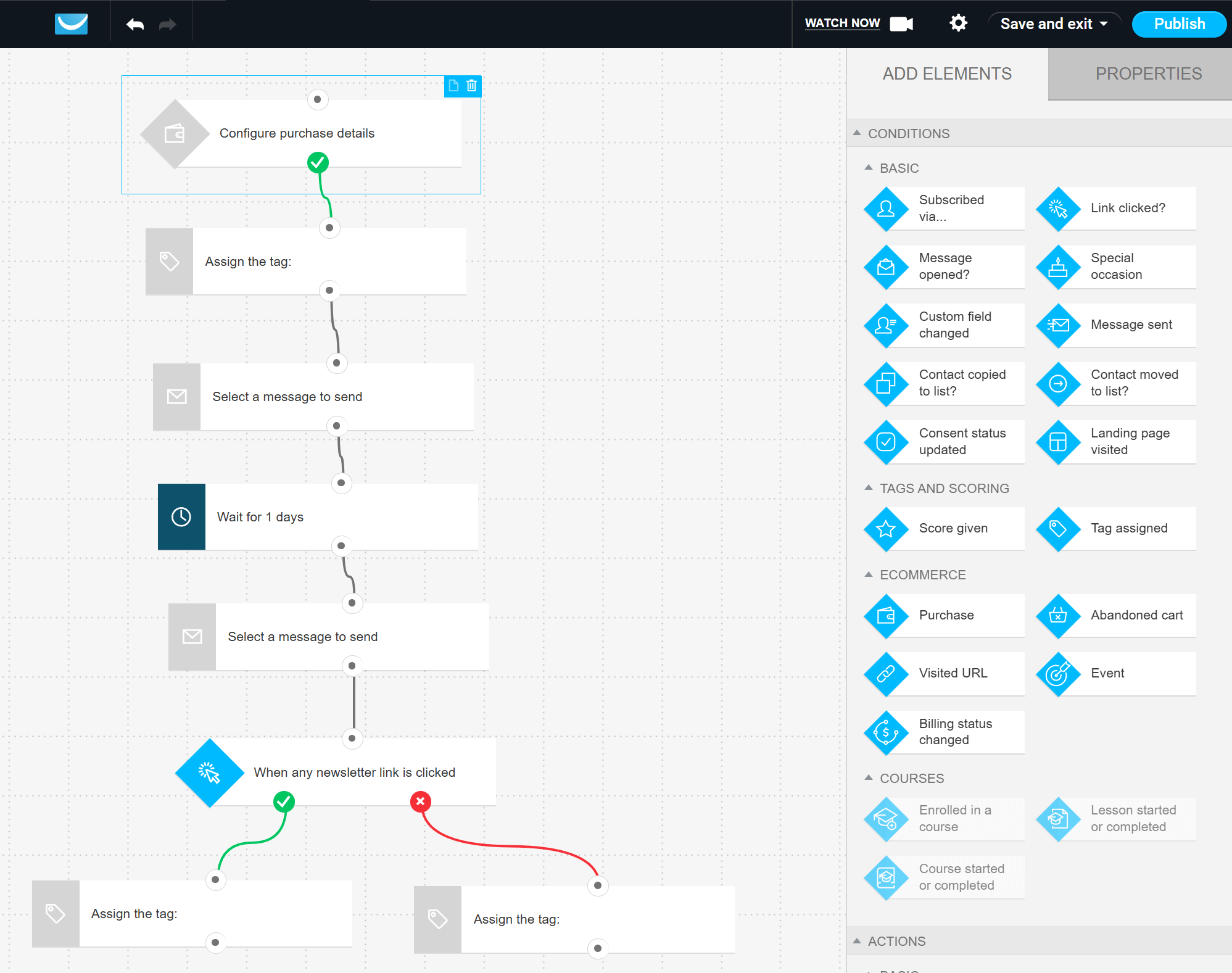
Testing GetResponse’s visual workflow builder we saw that it’s slightly less intuitive than Mailchimp’s. However, it offers equally advanced automation as Mailchimp, while the color coding helps you understand which paths lead where. With GetResponse, you can also automate your lead scoring.
Additionally, the platform comes with 42 automation templates for sales promotion, lead qualifying, post-purchase, abandoned cart and more.
Where GetResponse really shines, though, is in segmentation. Using the dynamic segment filter, you can target your audience with accuracy and deliver tailored content that resonates with them.
Another unique feature of the platform is conversion funnels. These are pre-built scenarios made to sell, build your contact lists, showcase offers, and help you grow.
Finally, with GetResponse you can send automated push notifications and SMS messages (not available in all plans, though.)
Winner: In this GetResponse vs Mailchimp automation showdown, GetResponse emerges as the winner since it provides more options that let you build a multi-channel marketing strategy. However, if you rely on pre-built automation recipes, then Mailchimp would be a better choice.
List Management
Mailchimp:
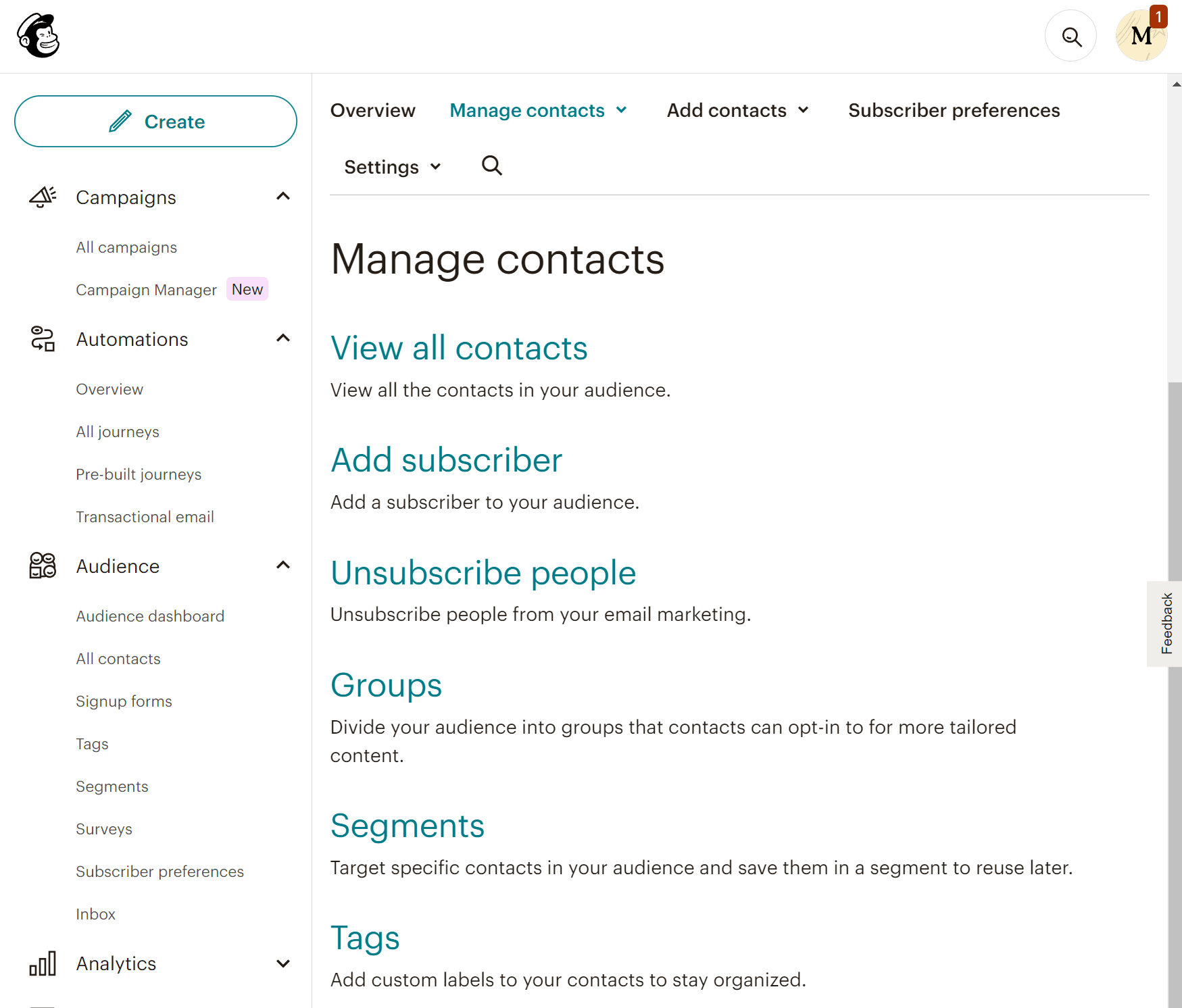
Mailchimp’s approach to contact management is unique. The platform offers multiple tools for organizing subscribers, including segments, groups, and tags. While these options provide flexibility, the differences between them may not be immediately clear, which can be confusing for first-time users.
In Mailchimp, you have “Audiences,” which function as distinct lists. However, a key drawback is that if a subscriber appears on multiple audiences, they are counted—and charged—separately, potentially leading to higher-than-expected costs.
Segmentation is one of Mailchimp’s strong points, allowing marketers to target subscribers based on various criteria, such as demographics, location, language, or signup source. Advanced segmentation capabilities include using eCommerce data like purchase behavior, abandoned cart details, and campaign interactions. Additionally, on Mailchimp you can create a preference center, giving subscribers control over how they wish to receive communications.
For marketers, Mailchimp’s segmentation features can be powerful, but understanding its contact management structure is essential to optimize costs and leverage its full potential.
GetResponse:
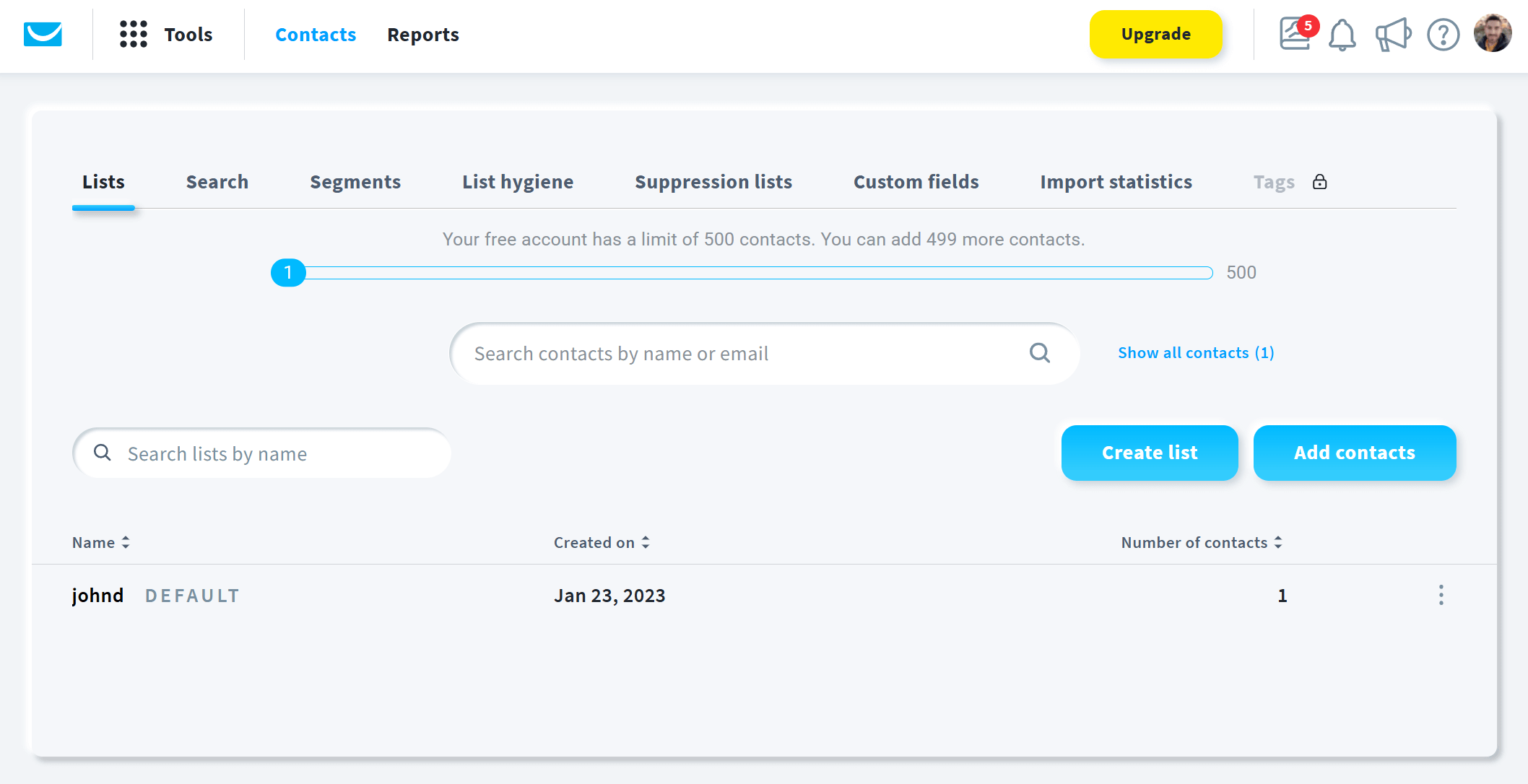
Unlike Mailchimp, GetResponse has the power to perform more complex list management. For example, you can copy contacts to another email campaign or remove them entirely.
Regarding your segments, you’ll be able to add any/all conditions to users, and even groups. This means you have more customizability than Mailchimp. Additionally, with the Engagement Score feature the platform assesses subscriber interactions, facilitating segmentation based on engagement levels.
Winner: Segmentation and list management are more flexible in GetResponse. This is among the main reasons why GetResponse wins this one.
Reporting & Analytics
Mailchimp:
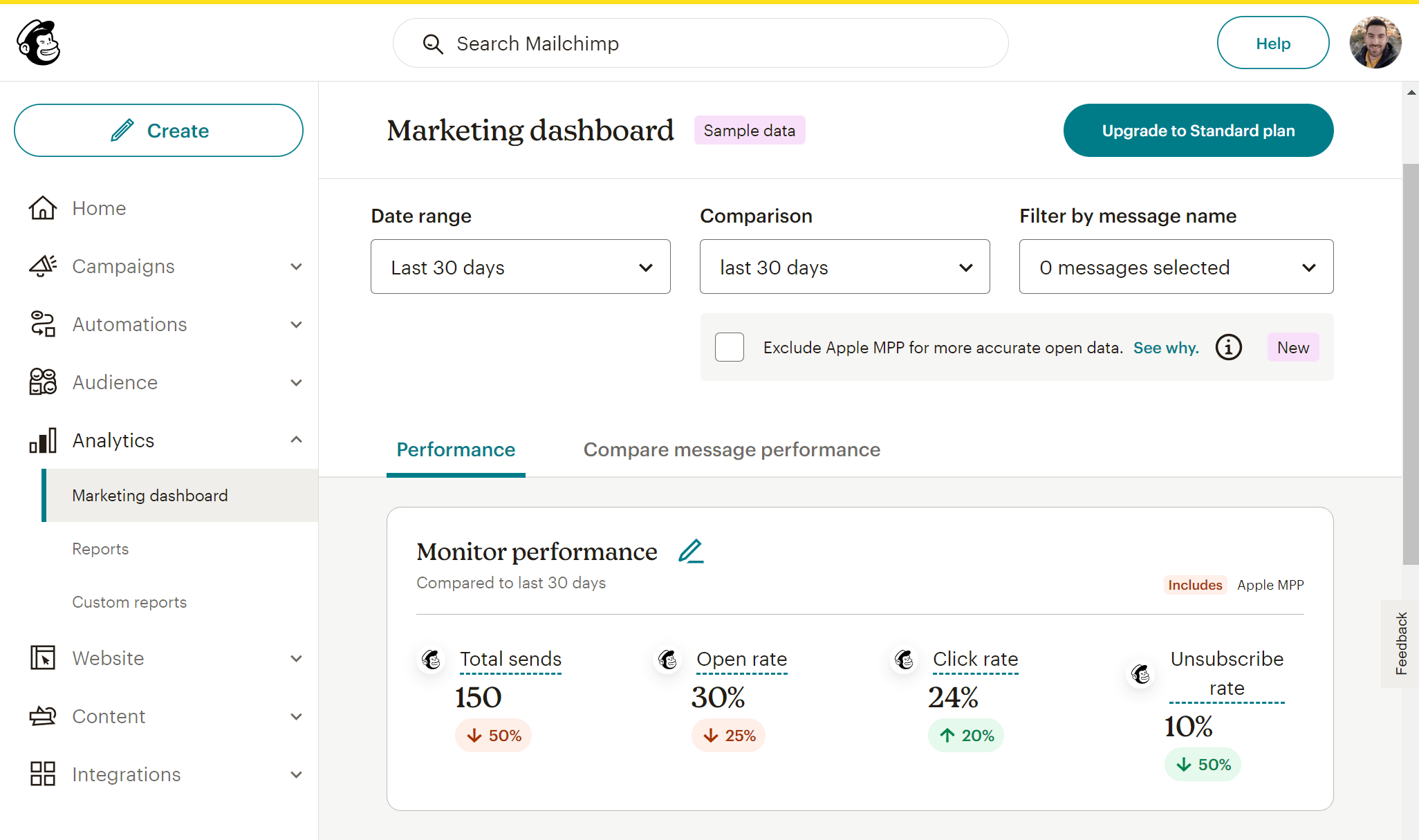
Mailchimp offers robust reporting and analytics capabilities that provide valuable insights for optimizing email marketing campaigns. The platform tracks essential metrics, including click-through rates, open rates, bounces, and unsubscribe trends. Additionally, it has advanced features such as email client data, social media performance analytics, and click maps, offering a comprehensive view of audience interactions.
For businesses focused on eCommerce, Mailchimp delivers detailed eCommerce reports to analyze sales performance and customer behavior. With its integration with Google Analytics, you can dive deeper into your conversions and track how each campaign affects them.
Higher-tier plans unlock custom reports and comparative analytics, allowing businesses to tailor insights to their specific needs.
GetResponse:
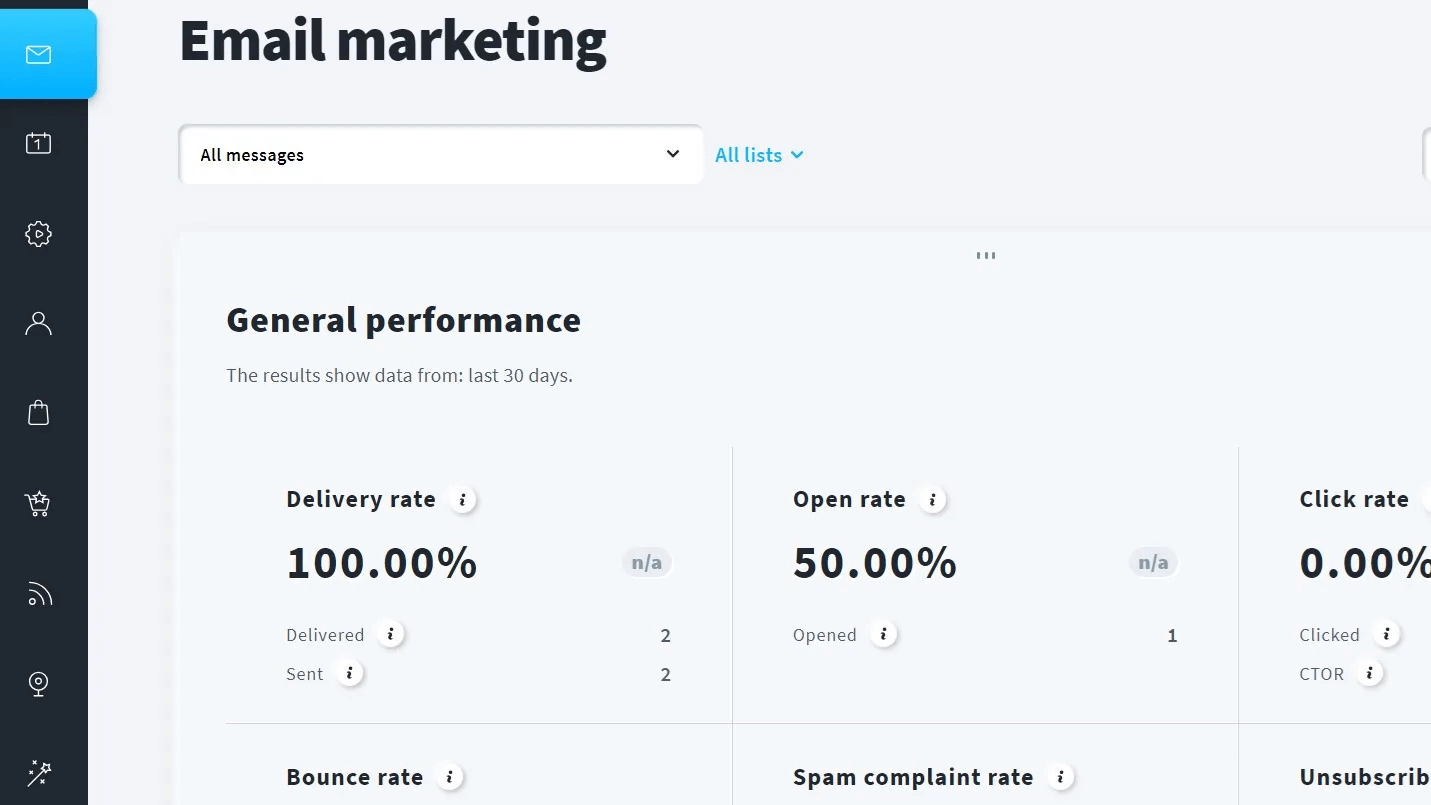
Reviewing the reporting and analytics tools of GetResponse, we found that they are user-friendly, visually appealing, and highly customizable. The platform tracks opens, clicks, bounces, spam complaints, and unsubscribe rates. You also get additional data about the number of emails that were sent and delivered.
The platform also includes more in-depth reports, such as eCommerce and product recommendation reports. For advanced users who want to dig deeper, GetResponse offers custom reports that include data points not available in standard reports.
We also found that GetResponse can automatically generate emailable “groups”. Essentially, when an email is sent, GetResponse shows you several segments of contacts who took specific actions. For example, you’ll see groups of people who opened your email, clicked your email but did not do an action, etc. This way, you can send relevant follow-ups or quick reminders. In Mailchimp, you don’t get this useful functionality.
Winner: Both email marketing apps have decent reporting and analytics tools, but Mailchimp is a bit more comprehensive.
Forms & Landing Pages
Mailchimp:
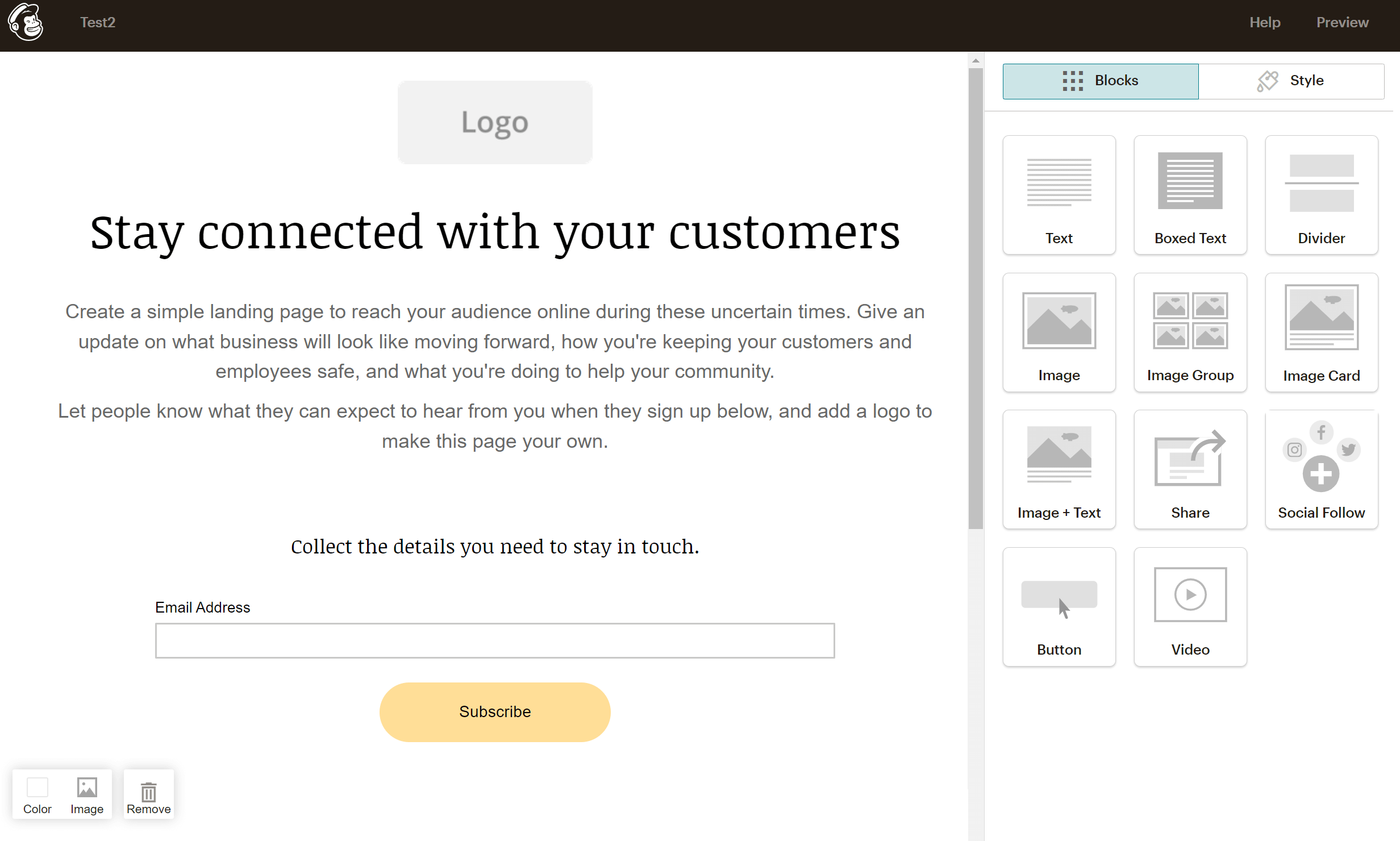
In this GetResponse vs Mailchimp review, we also got to test the lead generation tools of both platforms. Mailchimp’s form builder is straightforward, offering options for embedded forms, popups, and signup landing pages. While functional, not all templates are responsive. To add some flexibility, there are integrations with platforms like WordPress and MailOptin.
The landing page builder features drag-and-drop functionality, making it easy to design visually appealing pages. However, the tool can feel sluggish, and experienced users may find the interface and options somewhat limited. A key limitation is the inability to build landing pages from scratch, as users must edit from a small selection of pre-designed templates. This restricts creative freedom and may not meet the needs of users seeking fully customized designs.
As a side note, we found these features located under the ‘Audience’ tab. This may not be immediately obvious to all users, thus causing unnecessary frustration. A quick way to access them is by clicking ‘Create’ in the top left corner.
GetResponse:

GetResponse lets you create various popups including promo bars, signup forms, and download prompts that are triggered by actions like scrolling or exiting a page. Alternatively, you can create embeddable forms for your website. In total, we found 186 pre-made designs for both types. As for the builder itself, it has ample customization options including the ability to add timers, promo codes, and videos.
Moving on to the landing page builder, we really liked how clean and easy it feels to use it. You’re able to add both simple and more advanced elements like webinar signup forms, product boxes, and countdown timers. You can conduct A/B testing and discover what works best for your audience in order to increase conversions and sales.
If you’re pressed for time, the AI landing page creator will be a huge help.
Winner: The tools offered by Getresponse provide better ease of use as well as advanced functionality that you don’t find in Mailchimp. GetResponse wins.
Mailchimp vs GetResponse: Email Deliverability
High email deliverability is essential for effective email marketing. When you spend time and money designing the “perfect” email campaign, you want it to reach subscribers’ inboxes and not the spam folder.
Emailtooltester has conducted email deliverability tests that demonstrate the most reliable email marketing services based on their deliverability. Here are the results:
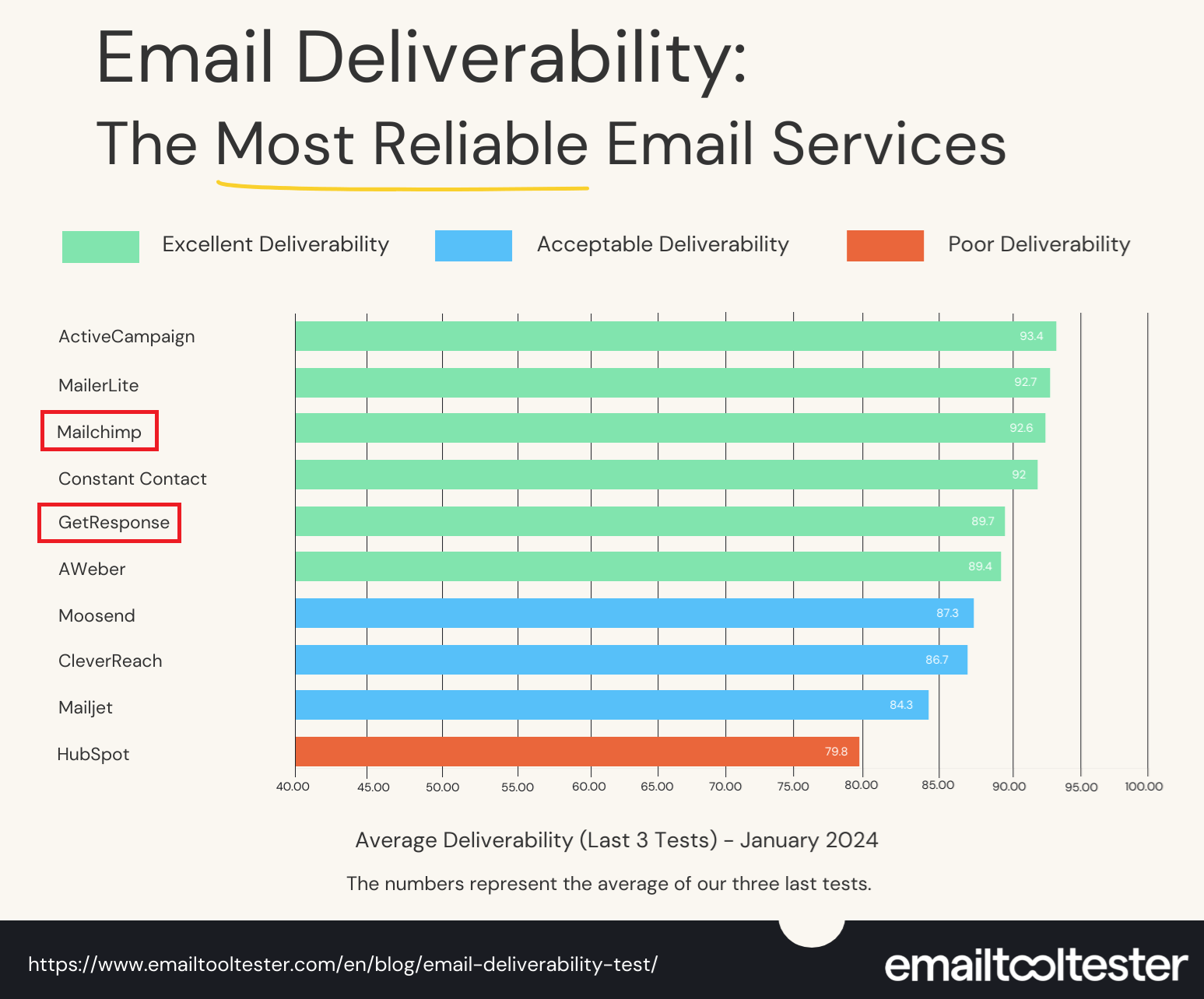
Mailchimp is in the third position, boasting excellent deliverability with an average score of almost 93%. GetResponse ranks a little lower with an average score of 90%.
At this point we should note that these results can vary from sender to sender. Nevertheless, they provide an insight into what you can expect from each email marketing platform should you decide to select one of them for your business.
Winner: Both Mailchimp and GetResponse offer an excellent email deliverability rate according to the tests. So, this one is a tie!
Mailchimp vs GetResponse: Integrations
Mailchimp:
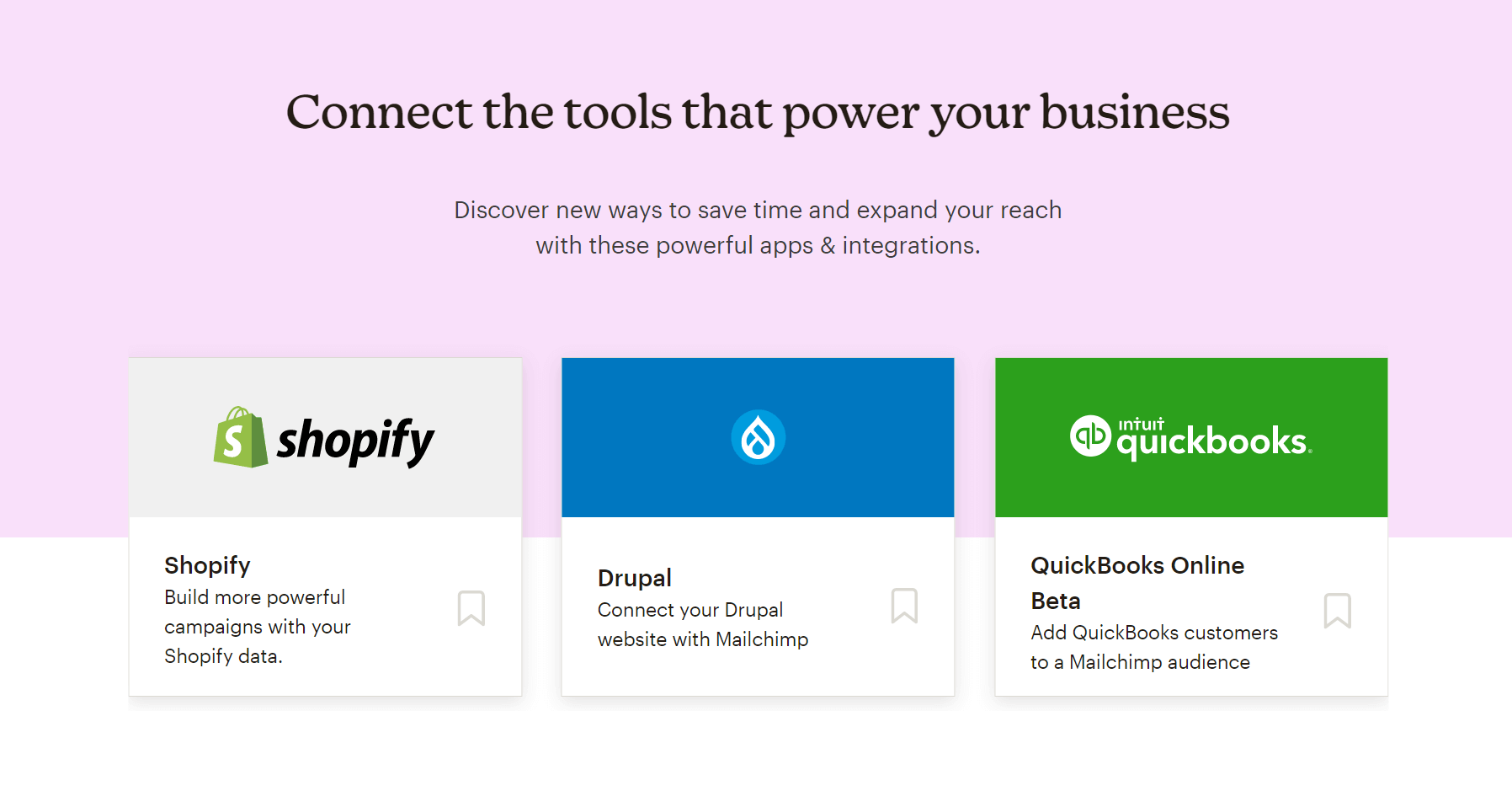
Mailchimp’s platform has one of the largest integration directories among email marketing services. There are 330 integrations with third-party apps, helping you connect with CRM tools, eCommerce platforms, lead generation services, and more.
If you plan on connecting your favorite marketing apps with Mailchimp, it will be hard not to find the one you need.
GetResponse:
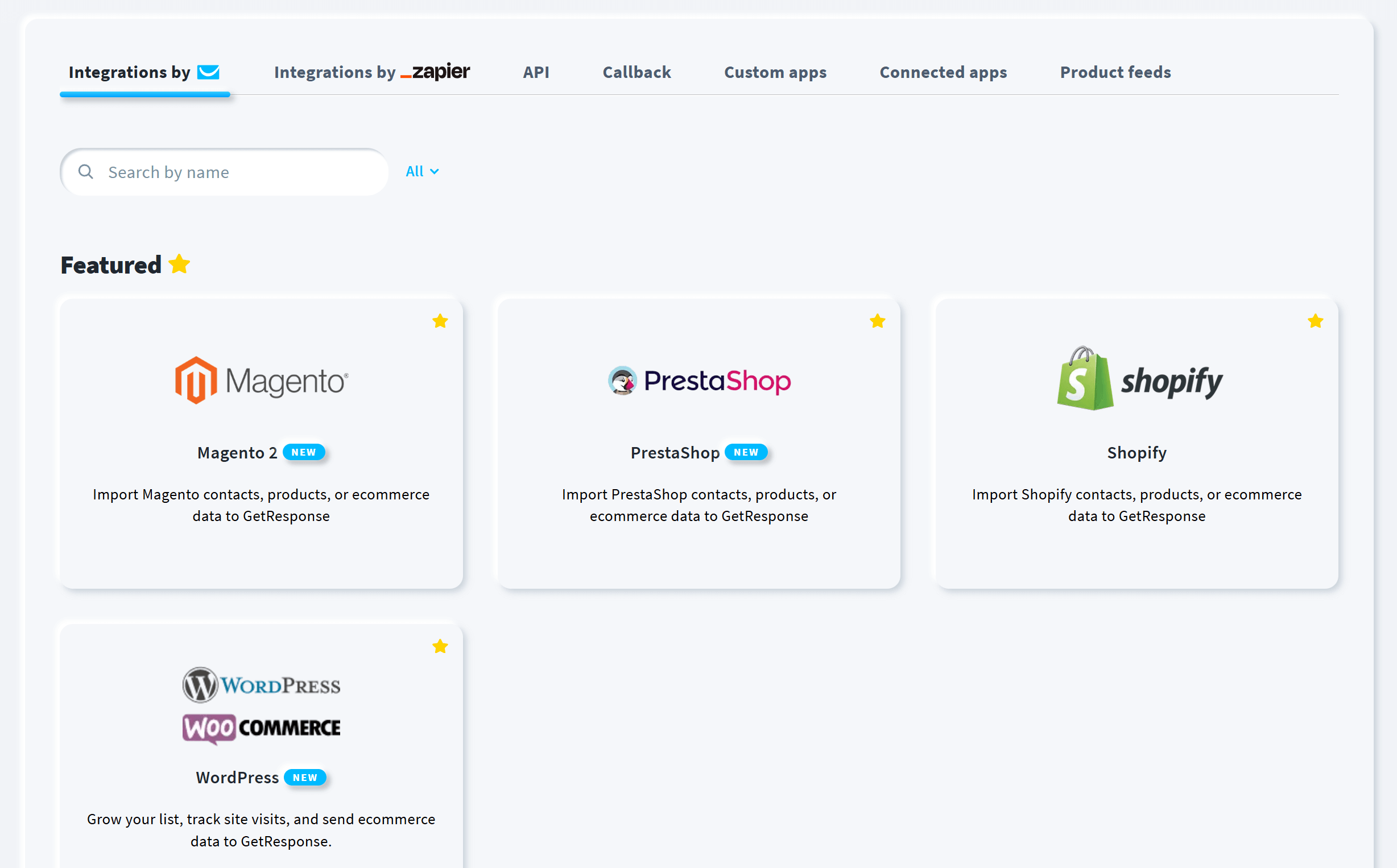
GetResponse integrates with fewer services than Mailchimp, but the number of integrations available is still impressive (and adequate for most users). Specifically, there are 185 integrations with social media, CRM, eCommerce, and website builders.
Some integrations are offered directly by GetResponse, while for others you’ll need to use Zapier.
Winner: Mailchimp wins this one mainly due to the high number of integrations it offers, making it an ideal choice for all kinds of users.
Mailchimp vs GetResponse: Customer Support
Mailchimp:
Mailchimp offers different levels of customer support based on your plan. If you are on the free plan, you will only have email support for the first 30 days. For all paid plan users, Mailchimp offers 24/7 live chat and email support. For its top tier plan, the Premium plan, the platform provides phone and priority support.
On top of this, Mailchimp has a great knowledge base with guides and tutorials to help you out.
GetResponse:
In GetResponse, things are similar. All paid plan users have access to 24/7 live chat support and support via email. For users on the 30-day trial, support is the same as for paid plan users. After the trial period, though, you cannot contact the Customer Success team, and you can only access Help Center materials.
For the top tier plan, the MAX plan, GetResponse offers additional phone support.
Winner: This is a tie since the two services don’t have any noticeable differences. Our only note here is that Mailchimp is notorious for having slow support times according to user reviews.
Mailchimp vs GetResponse: Pricing
It’s time to compare the two tools in terms of their pricing.
Mailchimp:
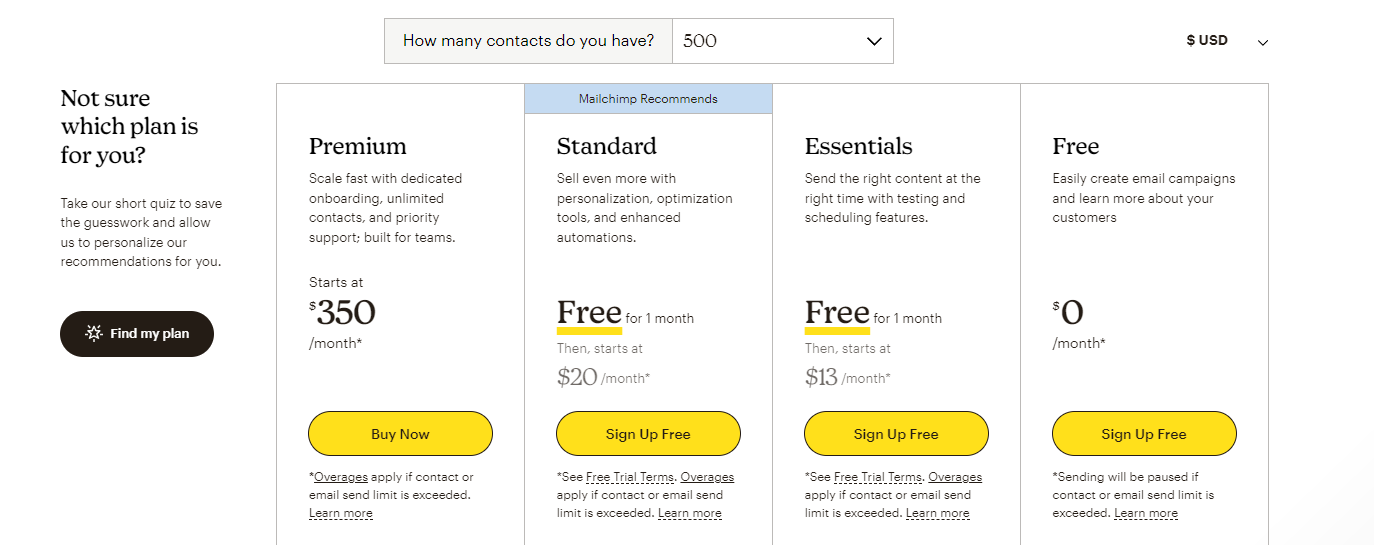
Mailchimp’s pricing consists of three paid plans and a free plan. Mailchimp’s free plan allows you to have 500 subscribers and send 1,000 monthly email campaigns. This plan used to be very popular, but after recent changes it has shrunk a lot, thus being adequate only for users with small email lists.
The first paid plan called the Essentials plan ($13/month) offers basic email marketing tools, while the Standard plan ($20/month) unlocks advanced segmentation, multi-trigger automation, retargeting ads, and multivariate testing.
Mailchimp’s Premium plan offers even more advanced functionality, which is ideal for larger organizations with specific needs.
GetResponse:
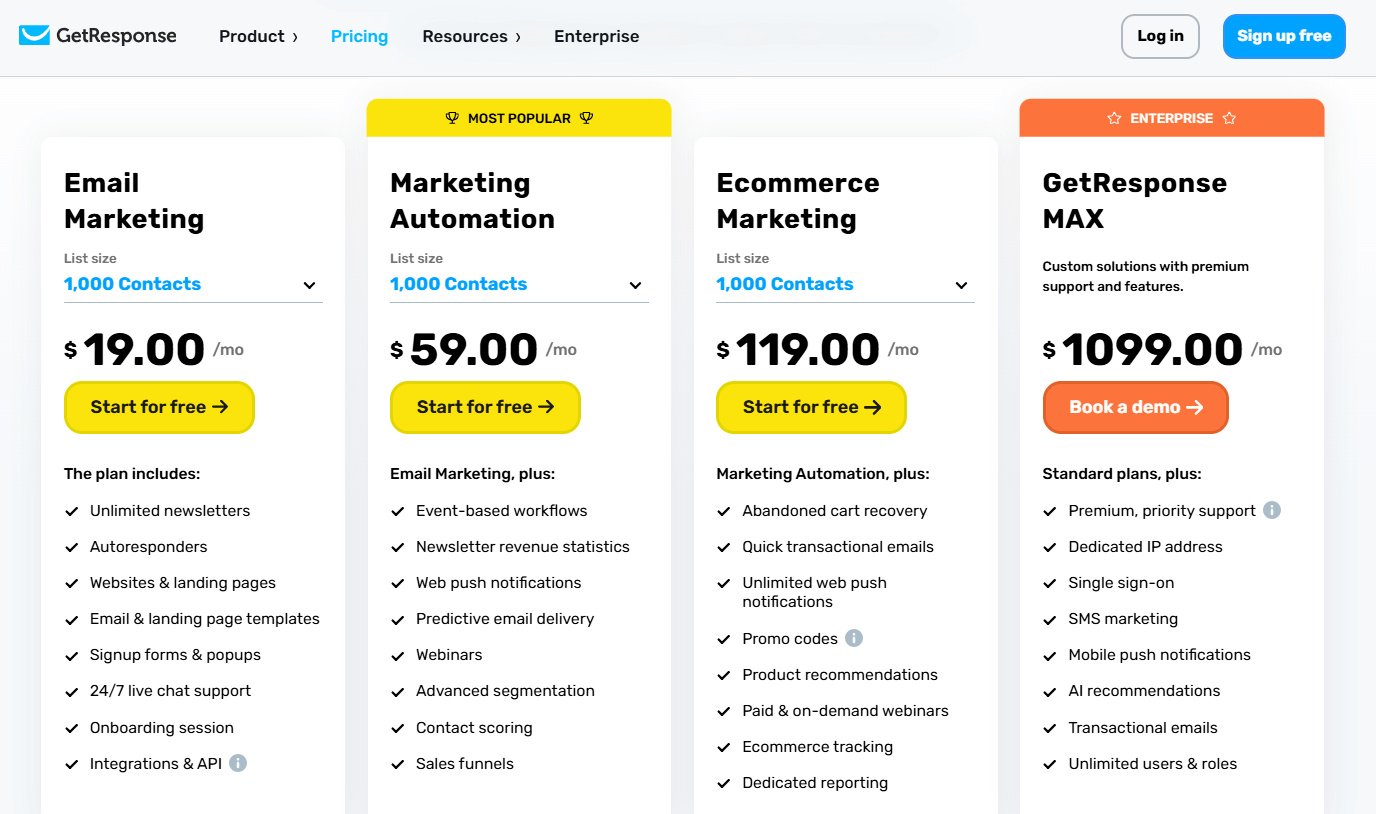
GetResponse has four paid plans available. The Email Marketing plan starts at $19/month and offers unlimited email newsletters, autoresponders, forms and landing pages, and 24/7 support.
For marketing automation workflows, web push notifications, advanced segmentation options and sales funnels, you need the Marketing Automation plan starting at $59/month for 1,000 contacts.
To unlock eCommerce functionality, promo codes, and eCommerce tracking, you need to pay $119/month for the Ecommerce Marketing plan. There is also the GetResponse MAX plan with custom pricing, including SMS marketing, transactional emails, and AI recommendations.
For new users GetResponse has a 30-day trial letting you test its premium features. After that period, your account becomes a free plan with 2,500 newsletters per month for 500 subscribers but no access to support.
Winner: GetResponse is slightly more affordable than Mailchimp, especially for smaller email lists. Its free version is more generous too. For these reasons, we give this win to GetResponse.
Top Mailchimp and GetResponse Alternatives
If you’re unsure about Mailchimp and GetResponse or you want to explore more alternative options, here are the top contenders.
1. Moosend
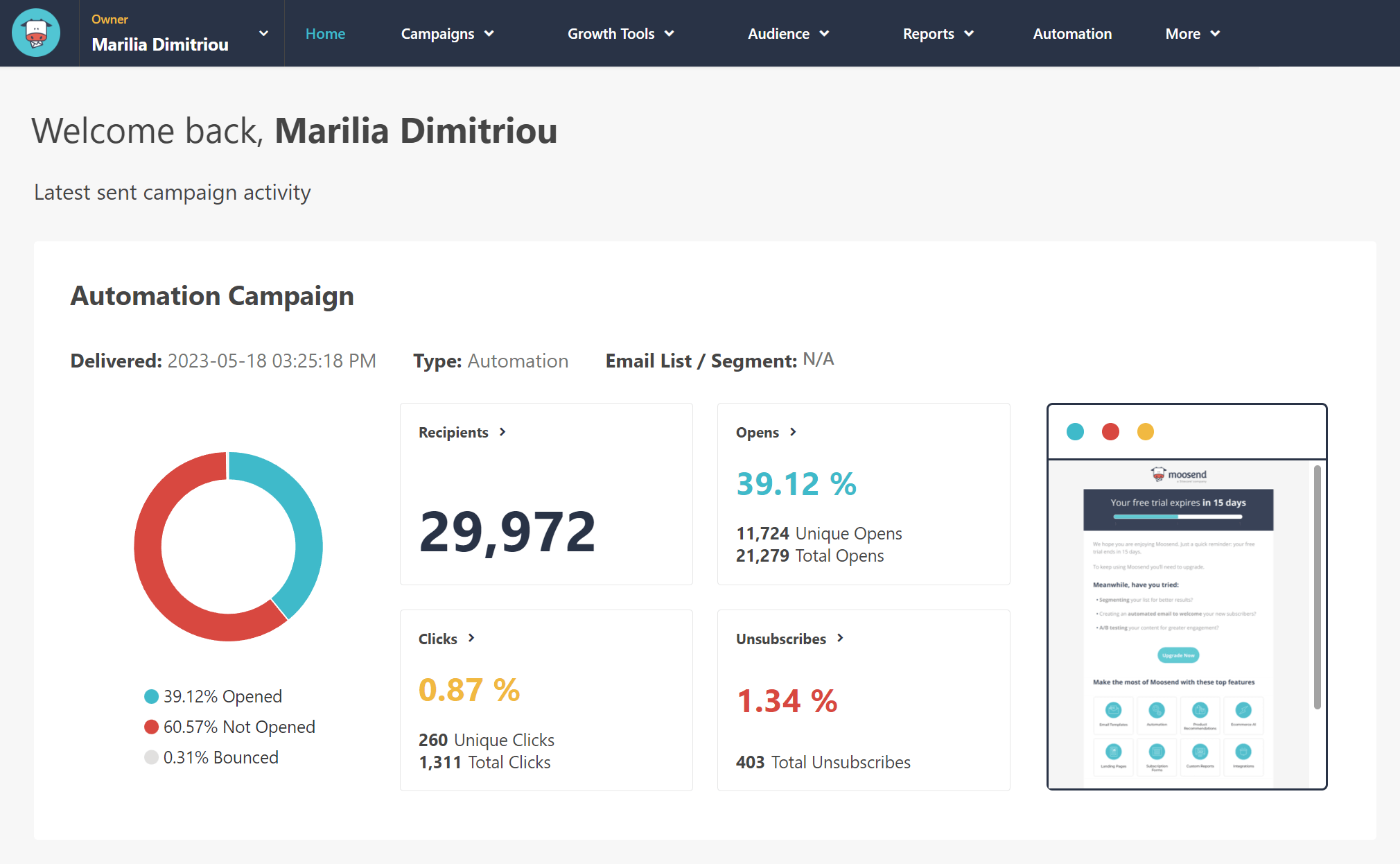
Pricing: Paid plans start at $9/month, 30-day free trial (Sign up here)
Best Feature: Powerful automation with a vast range of triggers
Moosend is a powerful email marketing and automation tool offering advanced features tailored for eCommerce and small businesses. You get a modern drag-and-drop editor with various advanced items like countdown timers, videos, and product blocks. To put your marketing on autopilot, you get a visual workflow editor with a vast range of triggers and actions (including eCommerce ones.) You also get flexible segmentation options to deliver laser-targeted campaigns and real-time analytics to track and optimize your performance. Finally, Moosend has a responsive 24/5 support team to help you out if you encounter any problems.
Why prefer Moosend: The service comes with powerful functionality at a more competitive price than GetResponse and Mailchimp, making it an ideal choice for small businesses and SMBs.
2. Constant Contact
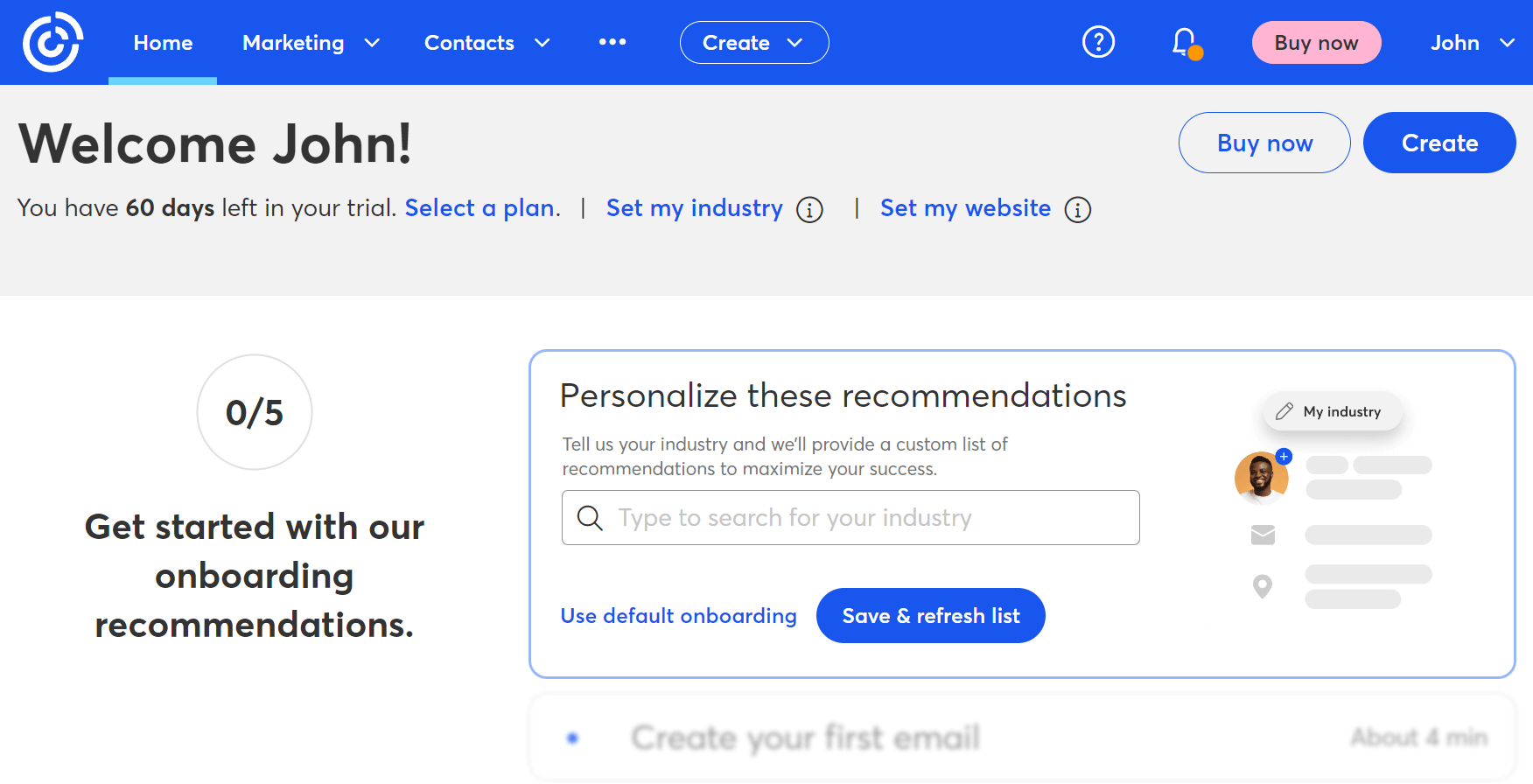
Pricing: Paid plans start at $12/month, 14-day trial
Best Feature: Event management tools
Constant Contact is a robust email marketing platform that stands out as a strong alternative to Mailchimp and GetResponse, particularly for small businesses and nonprofits. Its intuitive drag-and-drop editor and industry-specific templates can simplify the creation of professional emails. A standout feature is its seamless event management integration, so that users can send invites, manage RSVPs, and track attendance effortlessly. The tool can also integrate with eCommerce platforms like Shopify, WooCommerce, and Etsy, making it ideal for online retailers. Its social media tools, including ad creation and post scheduling, can help businesses build a complete digital marketing strategy.
Why prefer Constant Contact: This simple email marketing solution has a wide range of tools (ads, social media, revenue reporting, SEO recommendations) that can help small businesses amplify their reach and increase their revenue.
3. MailerLite
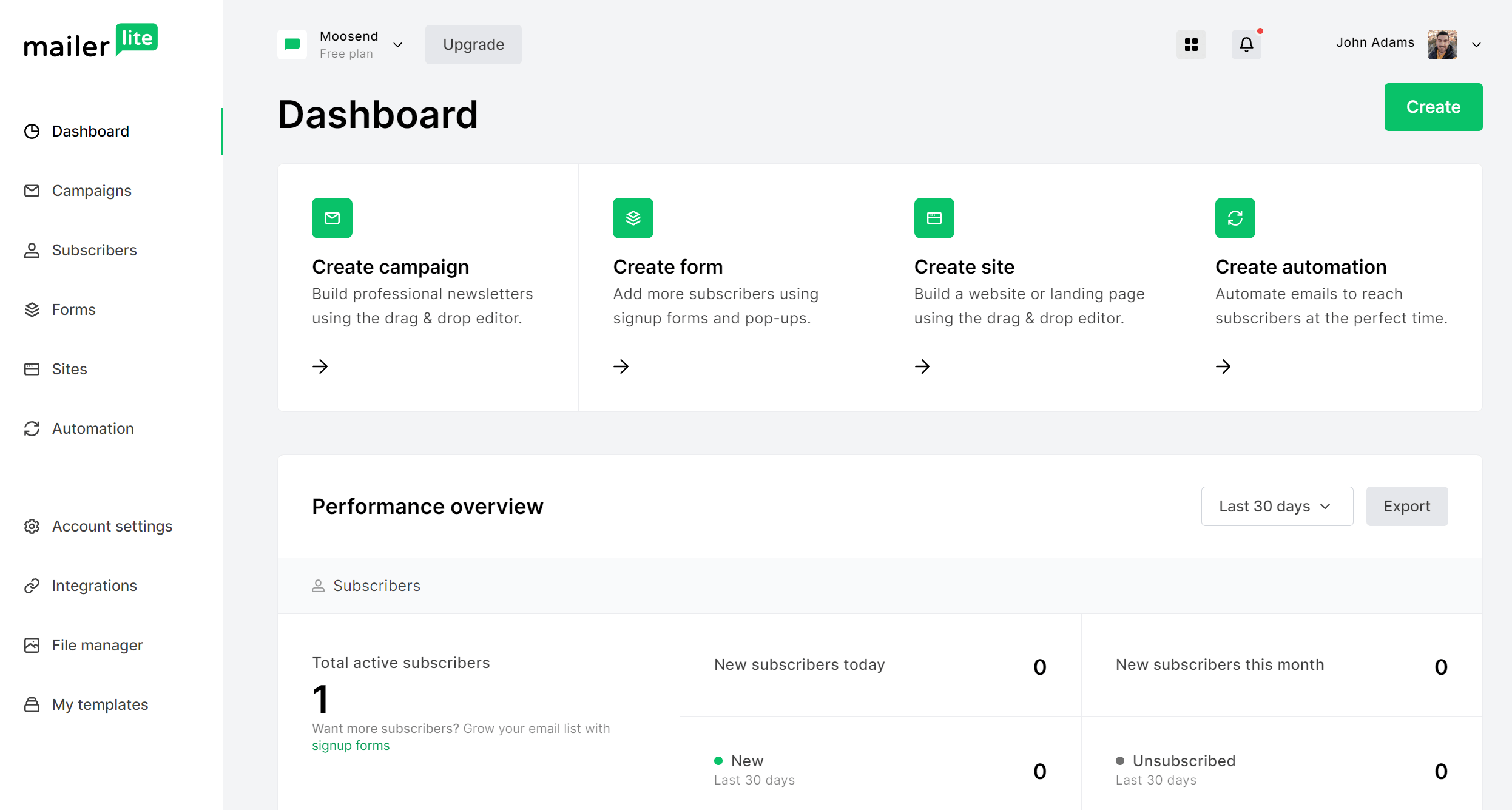
Pricing: Paid plans start at $10/month, free plan
Best Feature: Sell digital products and subscriptions
MailerLite is a popular email marketing tool offering several advantages over Mailchimp and GetResponse. You get a drag-and-drop email editor, beautiful pre-made templates, powerful automation features, and a landing page builder. MailerLite lets you create a website, blog, and unsubscribe page. On the top-tier plan, you also get AI tools, a preference center and access to the custom HTML editor.
Why prefer MailerLite: Mailerlite is an affordable solution offering advanced functionality that is ideal for small businesses or beginners.
Additional Resources to Check
Here are a few resources to expand your reading:
Mailchimp vs GetResponse: The Takeaway
By now, you must have a better understanding of the two tools compared above. Consider your specific needs and evaluate which service can be a better fit for your business. Our advice is to leverage the available free plans and trials offered and test each platform’s capabilities yourself.
If you’re unsure whether the two competitors will fit your needs, you can widen your search by looking at what other alternative solutions can offer.





 Published by
Published by
